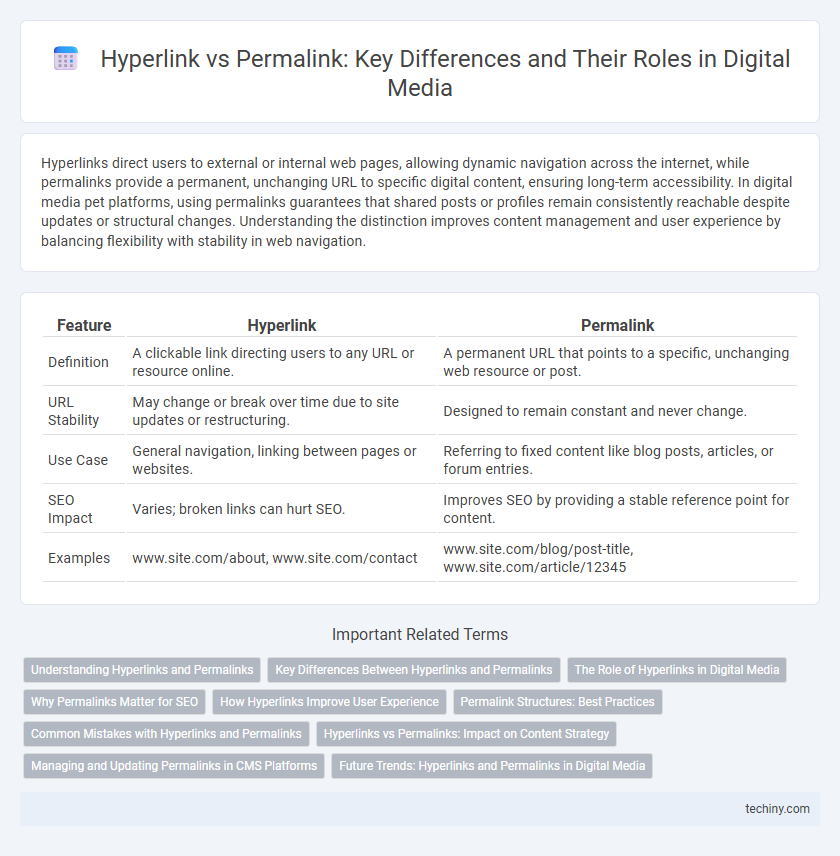Hyperlinks direct users to external or internal web pages, allowing dynamic navigation across the internet, while permalinks provide a permanent, unchanging URL to specific digital content, ensuring long-term accessibility. In digital media pet platforms, using permalinks guarantees that shared posts or profiles remain consistently reachable despite updates or structural changes. Understanding the distinction improves content management and user experience by balancing flexibility with stability in web navigation.
Table of Comparison
| Feature | Hyperlink | Permalink |
|---|---|---|
| Definition | A clickable link directing users to any URL or resource online. | A permanent URL that points to a specific, unchanging web resource or post. |
| URL Stability | May change or break over time due to site updates or restructuring. | Designed to remain constant and never change. |
| Use Case | General navigation, linking between pages or websites. | Referring to fixed content like blog posts, articles, or forum entries. |
| SEO Impact | Varies; broken links can hurt SEO. | Improves SEO by providing a stable reference point for content. |
| Examples | www.site.com/about, www.site.com/contact | www.site.com/blog/post-title, www.site.com/article/12345 |
Understanding Hyperlinks and Permalinks
Hyperlinks are clickable text or images that direct users to different locations within or outside a website, enabling smooth navigation and content discovery. Permalinks, or permanent links, are stable URLs intended to provide enduring access to specific web pages or posts, ensuring content remains reachable despite site updates. Understanding the distinction between hyperlinks and permalinks is crucial for effective digital media management, SEO optimization, and maintaining content accessibility.
Key Differences Between Hyperlinks and Permalinks
Hyperlinks are clickable references that direct users to a different web page or resource, often changing destination based on context or user interaction, whereas permalinks provide a permanent, unchanging URL that always points to the same specific content. Hyperlinks can lead to dynamic destinations such as search results or aggregated content, while permalinks ensure stable access to individual blog posts, articles, or unique digital media items. This distinction is critical for digital media management, ensuring consistent accessibility and reliability for linking and content sharing.
The Role of Hyperlinks in Digital Media
Hyperlinks serve as the backbone of digital media by enabling seamless navigation between web pages, enhancing user experience, and driving content discoverability. They facilitate the integration of multimedia elements and support the interconnected nature of online information, crucial for SEO and content marketing strategies. Unlike permalinks, which provide stable URLs for specific content, hyperlinks actively connect diverse digital assets, fostering engagement and dynamic content interaction.
Why Permalinks Matter for SEO
Permalinks provide a stable, unchanging URL structure that enhances user experience and improves search engine indexing, ensuring that content remains accessible over time. Unlike regular hyperlinks, permalinks prevent broken links and maintain link equity, which is crucial for maintaining and boosting search rankings. Consistent permalinks allow search engines like Google to effectively crawl and index pages, directly impacting SEO performance and organic traffic growth.
How Hyperlinks Improve User Experience
Hyperlinks enhance user experience by providing intuitive navigation paths that connect related digital content seamlessly, reducing the time users spend searching for information. They enable interactive engagement by allowing users to access multimedia resources, such as videos or articles, directly from relevant keywords or phrases. By facilitating quick access to authoritative sources, hyperlinks improve content credibility and user satisfaction in digital media platforms.
Permalink Structures: Best Practices
Permalink structures should be clear, concise, and keyword-rich to enhance SEO and user experience in digital media. Using hyphens to separate words and avoiding dynamic parameters ensures better readability and link stability. Consistent permalink formats across the website improve crawlability by search engines and establish trustworthiness for users accessing content over time.
Common Mistakes with Hyperlinks and Permalinks
Common mistakes with hyperlinks include using broken URLs, non-descriptive anchor text, and linking to unreliable sources, which can harm user experience and SEO. Permalinks errors often involve changing URL structures without proper redirects, causing link rot and loss of page authority. Ensuring stable, clear permalinks and regularly checking hyperlink validity prevents traffic loss and maintains site credibility.
Hyperlinks vs Permalinks: Impact on Content Strategy
Hyperlinks enable dynamic navigation across diverse digital content, enhancing user engagement and SEO by connecting relevant resources in real-time. Permalinks provide stable URLs that preserve content accessibility and continuity, crucial for maintaining consistent traffic and archival integrity. Effective content strategy balances both, using hyperlinks to enrich user experience and permalinks to ensure long-term content reliability.
Managing and Updating Permalinks in CMS Platforms
Managing and updating permalinks in CMS platforms requires careful planning to maintain SEO value and prevent broken links. Permalinks provide stable URLs that remain consistent despite content changes, unlike regular hyperlinks that can become outdated or lead to 404 errors. Effective CMS tools offer features for bulk updating permalinks, automatic redirects, and URL customization to streamline link management and enhance user experience.
Future Trends: Hyperlinks and Permalinks in Digital Media
Future trends in digital media highlight the growing importance of permalinks for ensuring content stability and SEO effectiveness, as these persistent URLs facilitate reliable access to web resources over time. Hyperlinks continue to evolve with interactive and immersive media, incorporating multimedia elements and augmented reality to enhance user engagement. The integration of AI and blockchain technology is expected to refine hyperlink tracking and permalink verification, improving authenticity and user trust in digital content.
Hyperlink vs Permalink Infographic

 techiny.com
techiny.com